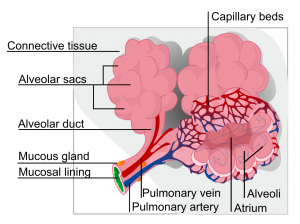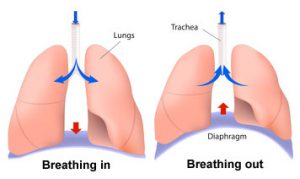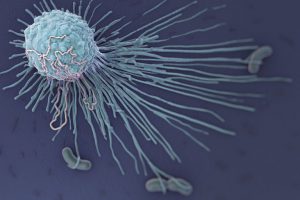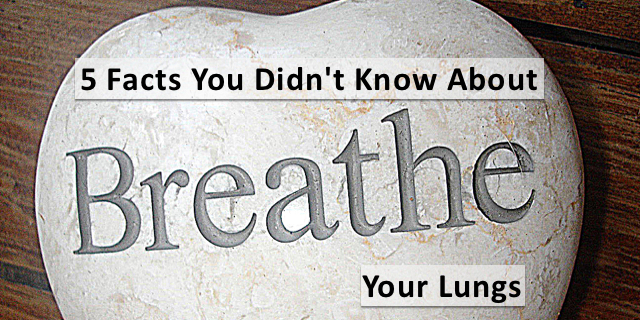On average we take 16 breaths in a minute. According to the EPA, that means we take between 17,280 and 23,040 breaths a day. That’s a lot.
Unconscious breathing is taken care of by our brainstem, so we never have to think about it. If we do think about controlling our breath, we are using our cerebral cortex. When we’re laughing, singing or talking, our cerebral cortex takes over. But we don’t have to worry about starting back up. Our brainstem is always around to keep our lungs breathing.
Here are some other facts you probably didn’t know about…
Your Lungs
![]() Your left lung is smaller than your right lung so that your heart can fit in your chest. There is a indentation in the left lung called the cardiac notch where the top of the heart rests. Your right lung has 3 lobes while your left lung has 2 lobes. You have 24 ribs, 12 on each side that protect your lungs and your heart.
Your left lung is smaller than your right lung so that your heart can fit in your chest. There is a indentation in the left lung called the cardiac notch where the top of the heart rests. Your right lung has 3 lobes while your left lung has 2 lobes. You have 24 ribs, 12 on each side that protect your lungs and your heart.
![]() Your windpipe or trachea branches like an upside down Y. The two arms of the Y are called bronchi (each is called a bronchus).
Your windpipe or trachea branches like an upside down Y. The two arms of the Y are called bronchi (each is called a bronchus).
Like a tree, the bronchi branch off into smaller and smaller tubes. The smallest are called  bronchioles. The walls of bronchioles are about as thick as a strand of hair. There are around 30,000 bronchioles in each lung.
bronchioles. The walls of bronchioles are about as thick as a strand of hair. There are around 30,000 bronchioles in each lung.
At the end of each bronchiole are clusters of tiny sacs called alveoli (one is called an alveolus). There are about 300 million alveoli in each lung.
Tiny capillaries, the diameter of one red blood cell, form a web like structure over the alveoli. Since the walls of the alveoli and of the capillaries are each one cell thick, our bloodstream is in close contact with the air. That contact allows for the exchange of oxygen and carbon dioxide–the primary function of the lungs.
the walls of the alveoli and of the capillaries are each one cell thick, our bloodstream is in close contact with the air. That contact allows for the exchange of oxygen and carbon dioxide–the primary function of the lungs.
![]() Your diaphragm is instrumental in the complicated mechanical process of breathing. This muscle separates your chest cavity (lung and heart cavity) from your abdominal cavity (where your stomach and intestines live). If your diaphragm is punctured, your stomach can move into your chest cavity and cause your lungs to collapse.
Your diaphragm is instrumental in the complicated mechanical process of breathing. This muscle separates your chest cavity (lung and heart cavity) from your abdominal cavity (where your stomach and intestines live). If your diaphragm is punctured, your stomach can move into your chest cavity and cause your lungs to collapse.
Inhaling
 At rest, your diaphragm has a concave shape. When breathing in air, this muscle contracts, flattening out and allowing more space for the lungs to expand. Intercostal muscles are the tiny muscles that are attached to your ribs: there are 11 pairs of external intercostals and 11 pairs of internal intercostal muscles. The external intercostals are the ones involved in the intake of air. When the external intercostals contract, they help to spread the ribs, giving more room for the lungs to take in air.
At rest, your diaphragm has a concave shape. When breathing in air, this muscle contracts, flattening out and allowing more space for the lungs to expand. Intercostal muscles are the tiny muscles that are attached to your ribs: there are 11 pairs of external intercostals and 11 pairs of internal intercostal muscles. The external intercostals are the ones involved in the intake of air. When the external intercostals contract, they help to spread the ribs, giving more room for the lungs to take in air.
The air coming into your lungs passes through the nose and down the trachea, into the bronchi, bronchioles and filling the alveoli. Oxygen moves from the alveoli into the capillaries and is taken up by the red blood cells.
Exhaling
At the same time that red blood cells are accepting oxygen from the alveoli, carbon dioxide moves from the blood into the alveoli.
Relaxation of the diaphragm and the external intercostals is part of the process of exhalation. The diaphragm returns to its concave shape reducing the size of the chest cavity. The internal intercostal muscles contract, pulling the ribs closer together adding to the reduction in the size of the chest cavity. Carbon dioxide, the waste product of respiration is breathed out.
The smooth action of inhaling and exhaling is helped by the pleural membranes, double layered, lubricated slick covers for the lungs. The inner layer that is next to the lungs is called the viscera pleura, the outer layer is the parietal pleura.
![]() Our lungs take in as much as 5000 gallons of air every 24 hours and with that air comes bacteria, viruses, mold, fungus and pollutants. How do our lungs stay healthy? Throughout the respiratory pathway, pseudostratified epithelium cilia line trachea, bronchi and bronchioles. Along with these cilia are goblet cells which produce mucus. Mucus traps harmful particles and cilia move the mucus away from the lungs to be coughed up.
Our lungs take in as much as 5000 gallons of air every 24 hours and with that air comes bacteria, viruses, mold, fungus and pollutants. How do our lungs stay healthy? Throughout the respiratory pathway, pseudostratified epithelium cilia line trachea, bronchi and bronchioles. Along with these cilia are goblet cells which produce mucus. Mucus traps harmful particles and cilia move the mucus away from the lungs to be coughed up.
 The alveoli have their own line of defense: alveolar macrophages. These are immune system cells that ingest foreign particles and digest bacteria and organisms. Neutrophils (another white blood cell) are also available to fight infections.
The alveoli have their own line of defense: alveolar macrophages. These are immune system cells that ingest foreign particles and digest bacteria and organisms. Neutrophils (another white blood cell) are also available to fight infections.
![]() Finally, you can live with only one lung and many people do.
Finally, you can live with only one lung and many people do.






Very nice illustrative article on lungs with proper pictures also.Very nice
July 2014 Bi-lateral LungTransplant survivor. Three weeks after transplant, my right lung lacked room because my diaphragm was up higher on that side. They did a procedure, that required the pulling of my diaphragm down. Are you familiar with it, and, what is it called?
Thanks
Can you expand in the Asthma Crisis and how to help the lung to heal?
Amazing post!
Knowledgeable post.
Thank you for your very clear information and explanation of the lungs.
Very good
Great explanation.. Truly appreciative..
Helped with my homework a lot.